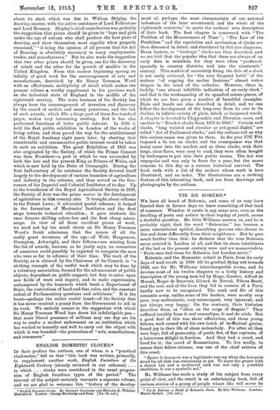ENGLISH DOMESTIC CLOCKS.* IN their preface the authors, one of
whom is a "practical clock maker," tell us that "this book was written, primarily, to supplement another work, English Furniture of the Eighteenth Century (already reviewed in our columns) . . In which . . . clocks were considered in the natal progres- sion of English furniture types of the period." The interest of the subject certainly Warrants a separate volatile, and we are glad to welcome this "history of the develop-
• English Domestic Clocks. By Herbert Cescinsky and Malcolm B. Webster. Illustrated. London : George Boutledie and Sons. [31s. Ed. net.]
ment of, perhaps, the most characteristic of our national industries of the later seventeenth and the whole of the
eighteenth centuries," to quote the authors' own description of their book. The first chapter is concerned with " The Problem of the Measurement of Time "; "The Law of the Pendulum" and the regulation and mechanism of clocks are then discussed in detail, and elucidated by full-size diagrams. Brass lantern, or " birdcage " clocks are then described, and we are told that the popular idea that these are always of an early date is mistaken, for they were often "produced, specially in country districts, well into the nineteenth" century. This matter of accurately fixing the date of a clock is not easily achieved, for " the very frequent habit" of the makers "of copying the earlier fashions" almost wakes despair in the mind of the collector. However, there is, luckily, "one almost infallible indication of an early clock," and that is the workmanship of its spandrel corner-pieces, of which we are here given a number of beautiful examples. Dials and hands are also described in detail, and we can follow the development of the long-ease from its rise to its decline, in infinite variety of plain, inlaid, or lacquered woods. A chapter is devoted to Chippendale and Sheraton cases, and another to "Bracket clocks from 1670 to 1800." Certain wall clocks, "long waisted and circular or octagonal-dialed," are called "Act of ParliaMent clocks," and the authors tell us why this curious name was given to them. In the year 1797 Pitt imposed a 5s. tax on clocks, and the consequence Was that many came into the market, and as these clocks, with their large, clear faces, were easy to read; they were often bought by innkeepers to put into their public rooms. The Act wall unpopular and was only in force for a year, but the tame remain's to this day as a curious historical survival. The book ends with a list of the makers whose work is here illustrated, and an index. The illustrations are a striking feature of this interesting book, and are from drawings and photographs by the authors.






























































 Previous page
Previous page